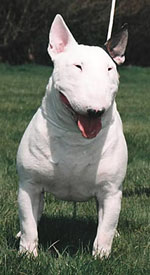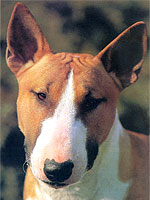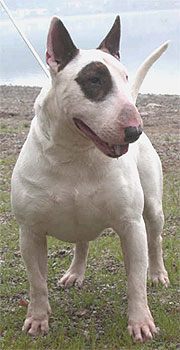English Bullterrier

 One of the most unique dog breeds, the English Bullterrier was once commonly referred to as the "Canine Gladiator" in its native Britain, where it was created in the 1850's by Birmingham's John Hinks. A wide variety of bull-n-terrier type dogs had already existed in Britain when Hinks developed his own line using local fighting and hunting dogs, mostly working Staffordshire bulldogges and terriers, alongside the already existing fighting sensation known as the Paddington Bull Terrier, as well as the short-lived, but almost mythical creation under the name of English White Terrier.
One of the most unique dog breeds, the English Bullterrier was once commonly referred to as the "Canine Gladiator" in its native Britain, where it was created in the 1850's by Birmingham's John Hinks. A wide variety of bull-n-terrier type dogs had already existed in Britain when Hinks developed his own line using local fighting and hunting dogs, mostly working Staffordshire bulldogges and terriers, alongside the already existing fighting sensation known as the Paddington Bull Terrier, as well as the short-lived, but almost mythical creation under the name of English White Terrier.
By combining the Paddington Bull Terrier and the English White Terrier with the Staffordshire dogs, Hinks established a line of fairly large and confrontational animals, with mostly black, brindle, red and piebald coats, which wasn't his goal, so a decision was made to incorporate more breeds into his efforts. Some authorities believe that the breeds that were used in Hinks' programme were the Foxhound, Spanish Pointer, Manchester Terrier, English Greyhound and the Russian Borzoi, but this isn't certain. Originally a superb fighting dog, as well as an outstanding hunter and ratter, the early Bullterrier was gaining great popularity among the "dogmen" of the time, but its temperament and overall appearance were severely altered when Hinks introduced the Dalmatian blood to the old Bully.
Wanting to develop a completely white dog, which he was successful at doing in 1860, Hinks not only diminished the breeds fighting abilities, but also introduced a number of health issues, like inherited deafness and skin problems, as well as kidney and heart diseases. However, these issues didn't prevent the "new" Hinks Bullterriers from becoming quite famous throughout England, where they were known as the "White Cavaliers", both for the colour of the coat and their personality, while other strains of the breed continued being bred and used solely for work, with little or no regard to colour or appearance preferences.

 Even though there is no proof that James Hinks ever participated in dog-fighting contests himself, the popular romantic story suggests that upon leaving the world of so-called "dog sports" behind them, Hinks and his Bullterrier traded the fighting ring for the show ring. In fact, Hinks' original intention was to develop a interesting-looking Show dog, but seeing how some of the parent breeds he opted to use as foundation stock for his creation were actual game dogs possessing superb working qualities, many of the examples produced by Hinks have indeed ended up in the hands of fighters, fairing exceptionally well in the matches, undoubtedly to the astonishment of James Hinks himself.
Even though there is no proof that James Hinks ever participated in dog-fighting contests himself, the popular romantic story suggests that upon leaving the world of so-called "dog sports" behind them, Hinks and his Bullterrier traded the fighting ring for the show ring. In fact, Hinks' original intention was to develop a interesting-looking Show dog, but seeing how some of the parent breeds he opted to use as foundation stock for his creation were actual game dogs possessing superb working qualities, many of the examples produced by Hinks have indeed ended up in the hands of fighters, fairing exceptionally well in the matches, undoubtedly to the astonishment of James Hinks himself.
While he was pursuing his vision of popularizing beautiful white Show dogs, the rest of the contemporary fighting and hunting community started utilizing Hinks' dogs for their own breeding programmes, all of which eventually led to the establishment of the recognized breed known as the Bullterrier, as well as influencing many other breeds of the basic bull-n-terrier type along the way, including the American Pit Bull Terrier in the United States, where the English Bullterrier enjoyed immense popularity as a fighting dog, Show contestant and family companion since the late 1800's.

 While James Hinks is commonly credited as the sole creator of the breed, other breeders played a role in the development of the Bullterrier also, namely Ted Lyon, Harry Monk and Billie Tuck, among others. Ted Lyon is credited with establishing and championing the brindle variety of the breed, while Harry Monk was instrumental in developing the erect ears in the Bullterrier after the ban on ear-cropping was passed in England. Monk also established the "downface" head, the breed\'s trademark, which was then perfected by Billy Tuck. It is believed that the appearance of the popular "egg-head" physical feature was due to the old terrier and greyhound ancestry, but the use of Scottish Collies and Whippets has also been suggested, as well as generations of inbreeding which helped solidify the physical trait.
While James Hinks is commonly credited as the sole creator of the breed, other breeders played a role in the development of the Bullterrier also, namely Ted Lyon, Harry Monk and Billie Tuck, among others. Ted Lyon is credited with establishing and championing the brindle variety of the breed, while Harry Monk was instrumental in developing the erect ears in the Bullterrier after the ban on ear-cropping was passed in England. Monk also established the "downface" head, the breed\'s trademark, which was then perfected by Billy Tuck. It is believed that the appearance of the popular "egg-head" physical feature was due to the old terrier and greyhound ancestry, but the use of Scottish Collies and Whippets has also been suggested, as well as generations of inbreeding which helped solidify the physical trait.
The white Bullterriers were immensely popular right away and to this day, they are still more common than the coloured dogs, even though the non-white Bullies are reportedly much healthier. Since 1936, the White Bullterrier and the Coloured Bullterrier have been officially separated and are still shown as two different breeds in many Dog Shows, although many fanciers continue to view them as being nothing more than two varieties of the same breed. It should be noted that many people believe that the majority of coloured Bullterrier lines do contain more early Irish Staffordshire and English Staffordshire blood than their white counterparts, a notion which serves as the basis for the separation of the two varieties among many breed purists, especially when the often-observed differences in temperament, working ability and health are taken into consideration. While there are still some capable working specimens within the white population of the breed, there are many more of such dogs to be found in the Bullterrier's coloured variety, used for ratting, hunting, fighting, cattle control, property guarding and personal protection.

 Unfortunately, the breed as a whole does have its share of health issues, such as deafness, skin infections and heart, kidney and elbow problems which, while more often noticed in the white variety, can affect all Bullterriers. Another condition known as S.O.A. or "Sudden Onset Aggression" has been observed in the breed, which manifests itself in seemingly unprovoked outbursts of rage, oftentimes directed at familiar dogs and humans. In most cases, the dog wakes up from a deep sleep and attacks the first being in its path, returning to its normal state afterwards, appearing to have no recollection of the incident. While very unpleasant and possibly tragic, this condition has nothing to do with the dog's upbringing and training, but is instead thought to be genetic in nature and while it affects a relatively small part of the breed's population, it is believed to be present in all of its bloodlines.
Unfortunately, the breed as a whole does have its share of health issues, such as deafness, skin infections and heart, kidney and elbow problems which, while more often noticed in the white variety, can affect all Bullterriers. Another condition known as S.O.A. or "Sudden Onset Aggression" has been observed in the breed, which manifests itself in seemingly unprovoked outbursts of rage, oftentimes directed at familiar dogs and humans. In most cases, the dog wakes up from a deep sleep and attacks the first being in its path, returning to its normal state afterwards, appearing to have no recollection of the incident. While very unpleasant and possibly tragic, this condition has nothing to do with the dog's upbringing and training, but is instead thought to be genetic in nature and while it affects a relatively small part of the breed's population, it is believed to be present in all of its bloodlines.
True EBT enthusiasts feel that the responsible breeders selecting for functional bodies and stable temperaments without sacrificing the recognizable appearance and character of the breed are the ones which should be endorsed and promoted by Bullterrier lovers, rather than those breeders whose programmes revolve around Show titles, choosing to breed for extreme looks and uncharacteristically docile temperaments, which are sadly much more numerous.

 A very muscular breed, the Bullterrier is extremely strong and powerful, which, coupled with its inherited high tolerance of pain, makes for a dog capable of doing almost anything when it sets its mind on it. A natural brawler and protector, it needs careful handling around other dogs and strange people, as well as broad socialization, early training and responsible ownership. Very friendly with familiar people and famously intelligent, the energetic Bull Terrier is a loving companion, but since it likes to play rough, the breed needs to be supervised around children, because it might unintentionally bump into them with its head.
A very muscular breed, the Bullterrier is extremely strong and powerful, which, coupled with its inherited high tolerance of pain, makes for a dog capable of doing almost anything when it sets its mind on it. A natural brawler and protector, it needs careful handling around other dogs and strange people, as well as broad socialization, early training and responsible ownership. Very friendly with familiar people and famously intelligent, the energetic Bull Terrier is a loving companion, but since it likes to play rough, the breed needs to be supervised around children, because it might unintentionally bump into them with its head.
And that is one powerful bump. The Bullterrier makes a very good watchdog and property guardian, as well as an all-around farm dog, but working examples are no longer as common as they once were. The most distinguishing physical feature of the Bullterrier is its large, broad head, with powerful jaws and downward-pointed stop-less muzzle, black nose, small expressive eyes and pointy erect ears, but not all dogs have the same head shape, especially in the working population, where examples with deeper stops, drop ears and even red noses can be encountered. There is also a Miniature Bullterrier breed, which is a fairly popular companion and Show dog worldwide.

 Even though the Bullterrier has been a fairly consistent and uniformed dog for many years, there are still 4 basic types observed within the breed, these being the stocky "Bulldog" type, the lean "Terrier" type, the leggy "Dalmatian" type and the compact "Ideal" type, named according to the ancestral characteristics in terms of physical appearance that such varieties may display to this day, with all of them except for the "Ideal" type being undesirable. The coat is short and smooth, most commonly seen in white, with or without darker markings on the head.
Even though the Bullterrier has been a fairly consistent and uniformed dog for many years, there are still 4 basic types observed within the breed, these being the stocky "Bulldog" type, the lean "Terrier" type, the leggy "Dalmatian" type and the compact "Ideal" type, named according to the ancestral characteristics in terms of physical appearance that such varieties may display to this day, with all of them except for the "Ideal" type being undesirable. The coat is short and smooth, most commonly seen in white, with or without darker markings on the head.
It should be noted that apart from an occasional albino specimen, in reality there is no such thing as a truly white EBT, the coat appearing as being white due to the white masking factor affecting the colour, like in most canine breeds. Other colours are fawn, red, brindle, as well as various bicolours and tricolours. The all-black dogs are the rarest, alongside the increasingly hard to find black-and-tan variant. For the coloured variety, the brindle coat is the most valued one among the Bullterrier fanciers.
While there are no official size limits for the breed, the average height at the withers is around 22 inches, although smaller, as well as taller dogs do exist.
-
hinks created his line not the breed of Pitt & Terrier like louis Dobermann the brother martinez and many other breeder (s) as well as certain countries who have only developed their lineage (s) but created some dog unfortunately the pseudonyms offices and pseudonyms breeders do more on top of the dog than to care about the health of the dog
